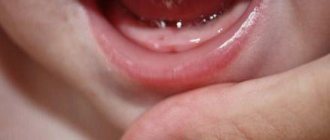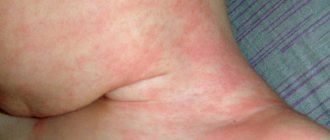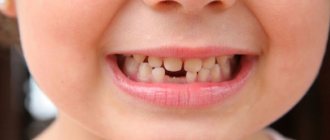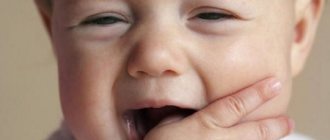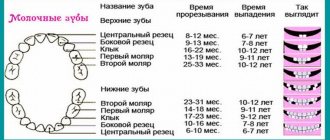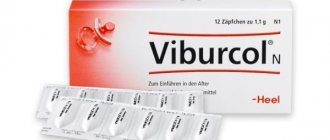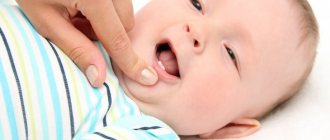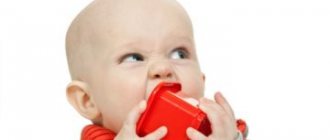Causes of itching in the ears
To understand why a child is scratching his ear, you need to pay attention to the presence of accompanying symptoms. Infants can pick at their ears even in the absence of pathological processes; the goal in this case is to explore their own body.
However, if your baby's skin is irritated or he scratches his skin until it scratches, most likely the reason lies deeper.
Diseases that cause itching
If a child constantly scratches his ear for several days, most likely the cause is a painful condition, since itching caused by external factors is short-term. Most diseases are accompanied by an inflammatory process.
Otitis of the middle and external ear
Otitis is an inflammation of the ear tissue. There are 2 types of disease depending on the location, cause of the disease and symptoms.
Otitis externa is caused by bacteria or fungal spores on the surface of the skin.
Factors contributing to the disease:
- ear injury;
- excessive cooling;
- water penetration;
- failure to comply with personal hygiene rules.
Symptoms:
- the pain becomes stronger when you press on the tragus (the bone next to the ear canal);
- inflammation;
- itching;
- purulent formations.
Causes of otitis media:
- upper respiratory tract infection – sinusitis, laryngitis, tonsillitis, etc.;
- acute viral diseases - influenza, measles, scarlet fever;
- otitis externa;
Symptoms:
- pain in the ear , crown, temple, head;
- discharge from the ear canal;
- noise in the ear, hearing one’s own voice (autophony), congestion, the sound of liquid splashing;
- hearing loss;
- children under one year old refuse breastfeeding , sleep poorly and cry a lot;
- heat.
Otomycosis
The cause of this disease lies in a fungal infection of the ear cavity. Otomycosis develops slowly compared to most other diseases that affect the ear. Symptoms may be mild or absent altogether, so the disease often remains unidentified.
It is especially difficult to identify otomycosis in infants under 6 months, since up to six months it is often impossible to indicate the cause of the discomfort.
What you should pay attention to:
- attacks of itching;
- swelling of the ear;
- white discharge;
- decreased child’s response to noise stimuli (congestion symptom).
An accurate diagnosis can be made by an otolaryngologist or infectious disease specialist by examining the ear for the presence of fungi.
Mastoiditis
This disease is a complication of advanced inflammation, which spreads to the tissues of the temporal region.
If otitis media is left untreated, the area becomes red and inflamed.
If a child has an itchy ear, a headache, or nausea, most likely otitis media has led to mastoiditis.
Psoriasis as a cause of itching in the ear
When a child's ear itches, and the itching is accompanied by burning, peeling and red rashes, the cause may be psoriasis. The rash may spread to the back of the head, scalp, ear and middle ear area.
This is a disease that affects the baby’s skin, and it should be treated by a dermatologist, however, consultation with an ENT doctor is also necessary to exclude the possibility of complications.
Allergy
An allergic reaction can manifest itself in two ways:
- The allergy does not affect the skin , but slight swelling appears and allergic otitis may occur in the future. It is distinguished from ordinary otitis by the absence of discharge.
- Allergic dermatitis - in this case, the skin is predominantly affected; hives, itching and peeling may appear.
With such symptoms, you should consult an allergist, dermatologist and ENT doctor. If a problem appears in a baby, you will most likely have to reconsider the diet of the nursing mother.
Mechanical ear injury
If the skin of the auricle or middle ear cavity is damaged, it may become inflamed and itchy. In the absence of disinfection, damage can lead to otitis media.
Young children often injure their ears when they try to push objects into them. A parent can also damage the ear cavity when trying to pull out a foreign object or carelessly cleaning the child’s ear.
Another possible reason is improper ear rinsing technique by an inexperienced otolaryngologist. If your baby cries and picks at his ear, check him for damage. If you find a foreign object, if possible, allow the doctor to pull it out so as not to injure the child.
Insect and parasite bites
In the case of mosquitoes, hornets, horseflies, a bite is clearly visible in the ear and itches. Don't let your child scratch the damaged area and the itching will go away quickly. To avoid scratching while sleeping at night, apply Fenistil to the bite, it will relieve itching and inflammation.
If you become infected with ear parasites (lice, fleas, ticks), you should contact your pediatrician and infectious disease specialist.
Symptoms of parasitic otitis media:
- swelling;
- inflammation;
- itching;
- peeling;
- small pustules.
Typically, infection begins in the outer ear. If left untreated, parasites can penetrate into the middle and cause serious complications.
Itching in the ear as a result of germs
Staphylococcus and streptococcus, when entering the ear canal, can cause severe itching and inflammation. The child may feel as if there is a foreign object in the ear. With further scratching, germs can be transferred from the fingers to other parts of the body, including mucous membranes.
In this case, you need to contact an ENT doctor and start treatment as soon as possible.
Itching in the ear due to insects
Sometimes an insect can get into a child's ear. Such incidents are quite rare and usually happen at night while the baby is sleeping. It is quite difficult to confuse this problem with a common disease, since in addition to itching, children are bothered by noise in the ear due to the movement of the insect.
Dr. Komarovsky strongly recommends against performing mechanical manipulations on children’s ears again; this case is no exception. Under no circumstances should you try to remove the insect yourself; contact an otolaryngologist, who will remove it without causing damage and perform an examination.
Causes of itching of the inner ear
Most often, the inside of the ear can itch for two reasons:
- Internal otitis;
- Trauma to the intra-ear cavity.
In both cases, a visit to an otolaryngologist is necessary. In case of a complicated illness or serious injury, subsequent hospitalization is possible.
Other causes of discomfort
- sulfur plug;
- inappropriate shampoo or soap;
- external irritants – high humidity, dust;
- teething;
- stagnation of water after swimming;
- increased nervousness. At the age of up to 4 months, the child needs to be provided with as calm a living environment as possible, since he is just getting used to a new way of life, and excess stress can manifest itself in anxiety, in which the baby cannot sleep and begins to fiddle with his ear.
Can ears hurt when teething?
" Health "
Question for experts: No fever, no runny nose. And still no teeth. You press the tragus in your sleep, sometimes it screams, and sometimes everything is fine. Screams not constantly, but periodically, but as if “cut.” At night I was looking for a forced position to fall asleep, sleeping on my left side.
Doesn't refuse food.
Best regards, Klyu
Best answers
these are signs of otitis media. Place drops in your ears and nose. and if the temperature rises, an antibiotic is needed. the spout needs to be dripped because the ears and spout are interconnected
call a doctor, don't guess)
Call an ambulance and don’t torture yourself or the Internet... The doctors would have arrived long ago... While you're asking questions... that the child is suffering...
look at the gums. Well, go to Laura for prevention. or an ambulance
That's right, only a doctor can determine. My daughter also recently had an earache, she complained about it, like a fool I started dripping there, but it turned out that it was a peritonsillar abscess in the throat! The pain just radiated into my ear.
Teeth are being cut, gums are inflamed, buy Kamistad gel (children's gel for topical use. For inflammation of the gums, etc.) A small drop on your finger and lubricate the gums. The child will stop getting sick and bothering him. (Even if it’s not an ear, it will be easier for the child to teethe) ...And before you see a doctor!
The child (if he cannot speak) screams, shows anxiety, rubs his head on the pillow, and does not sleep. With unilateral otitis media, the baby tends to take a forced position - lying on the sore ear, sometimes reaching out with his hand towards it. Children often refuse to eat or begin to cry while eating, because sucking and swallowing increase ear pain.
To determine the side of the lesion, you need to gently press on the tragus (the protrusion located in front of the ear canal) or pull the auricle down; the child begins to become restless or cry. The drugs of choice are Tsipromed, Otofa, Normax, Otipax. Vasoconstrictor drops in the nose are required before instillation of the ear.
Your child's behavior indicates otitis media. Get well!
if there are teeth, there are tubercles on the gums. but in any case, a doctor! do not be ill!!
-answer
This video will help you figure it out
Answers from experts
Since the upper part of the head, up to the mouth, is innervated by one nerve, the trigeminal, there may be lacrimation, drooling, clear nasal discharge, and discomfort in the ears. If you have ear pain, it is better to see an ENT specialist. Only these are not molars, but premolars.
Such teeth do not exist. XD Or are you just counting them in order? When teeth are being cut, everything can hurt.
Maybe, but otitis media needs to be ruled out
If the tooth count is correct, then there is a 55th tooth. Yes, only the 19th and 20th teeth according to any classification is a paradox. Are there 19 teeth in total in your mouth? Then it is unknown which teeth we are talking about, the pain can radiate anywhere, including to the ears...
Oh, I remember, my 39, 42, 94 and 101 were cutting through - it’s amazing how the pain went away)))))
Against the background of teething, the immune system may decrease, as a result, the child gets sick, and accordingly, the teeth and throat and anything else can hurt (Therefore, it is worth showing the baby to the doctor, an ENT doctor is sure to have him look at the ears.
Pain that occurs in the gum can radiate to the ear or cheek. Therefore, children may rub their cheek or ear, but in fact the cause of the pain is in the gum, at the site of tooth eruption.
The child experiences discomfort in places other than where it really hurts.
The process of teething can imitate inflammation in the ear, so it is worth contacting an ENT specialist to rule out otitis media due to the teething process.
Ears can also hurt when teeth come out. Use Kalgel.
Toothache can be transmitted to almost any part of the body, especially in a child with a young nervous system. but more often than not, of course. at least for me. the main thing is to make sure that it is not from the cold. anything can happen
In most children, each new tooth makes itself known long before it appears: the child has increased salivation, he stuffs everything that comes to hand into his mouth and chews it with ferocity or constantly puts his fist in his mouth.
Pain in the gums through the common pathways of the nervous system can spread to the ears and cheeks, especially when the incisors make themselves known, so some children pull their ears, rub their cheeks and chin.
But also remember that children also pull their ears when they have inflammation of the middle ear. If you suspect this disease, consult a doctor regardless of whether the child is teething at this time or not.
Since the blood supply to the jaw increases at this time, the baby often has red cheeks. The child is restless, capricious, crying and screaming. It's obvious he's in pain.
As baby teeth erupt through the periosteum and connective tissue, tension and pressure are felt in the jaw. The best remedy for pain is to chew a lot and gnaw on something hard and cold.
a piece of carrot or apple wrapped in a clean handkerchief, preferably from the refrigerator, as the cold brings additional relief. A pre-chilled chewing ring works well.
Hang in there, we are on your side!! ! Believe me, sooner or later they will come out!!!
Press on the ears, if they don’t wince in pain, then the ears are fine, it’s quite possible that the pain is coming from the tooth. Buy Colgel
It’s better to show the ENT out of harm’s way.
God forbid, otitis media (maybe it comes from a tooth, if those closer to the ear are cutting (and how old are you???!), but it may also coincide - how do you determine whether he is crying from his teeth or from his ear? ??? -no amount of pressure will help determine). Advanced otitis media - they shoot into the brain, and meningitis with encephalitis is bad.)) ) Sorry for the negativity - but I would be scared.
press on the tragus and check if there is a sharp cry or it is clear that it is not pleasant. may be otitis media. but there must also be a temperature with it. so show it to your doctor. You can also call an ENT specialist to your home (but for a fee)
Source: https://dom-voprosov.ru/zdorove/mogut-li-bolet-ushi-pri-prorezyvanii-zubov
Wisdom tooth
Not only children, but also adults, face the problem of teething. Wisdom teeth bring a lot of suffering to many of us.
Since they are located in the very corner of the jaw, and the gums are no longer able to loosen as in childhood, the tooth can be cut for several months, causing a lot of inconvenience.
There is discomfort when chewing, and some even experience a fever.
In severe cases, there is a feeling that the throat or ear hurts. The mechanism of formation of this phenomenon is the same as in children. But sometimes, when food or infection gets in, pus can form in the gum. Then an inflamed tooth can cause pharyngitis, otitis and rhinitis.
After tooth treatment
Quite a lot of painful sensations in the ear occur precisely after treatment of a tooth or its removal. The main reason for the development of such symptoms is unsuccessful manipulation and the development of an inflammatory process in the oral cavity.
The reason for the pain is that strong and extensive swelling and purulent processes have formed in the “socket”, as a result of which the unpleasant symptom will radiate into the ear. In this case, you need to consult a doctor as soon as possible. He should treat the wound with disinfectants or use laser procedures, which will relieve swelling and pain.
What does a hole in the gum look like after wisdom tooth removal?
Pulpitis
This disease very often causes pain in the tooth and ear. The fact is that the affected tooth reacts to heat, and the painful sensations spread to the ear and the entire temporal region. When pressing on the affected element, the pain syndrome increases and a “lumbago” occurs in the neck area.
Diseases of ENT organs
Oral cavity pathologies are quite often the main cause of the development of unpleasant symptoms. Simultaneous pain in the ear and tooth occurs with a disease such as trigeminal neuralgia.
The pain syndrome can occur sharply and suddenly, and lasts about 10-60 seconds. If during an attack the patient’s facial muscles contract and the color of the skin changes, then he should immediately consult a doctor.
Caries
If caries has leaked into the internal cavity, then urgent dental treatment is necessary. There are no alternative options, since the pathological process spreads gradually, destroying the jaw. As a result, nerve endings are exposed, sensitivity to cold and heat increases, and aching pain occurs.
Inspection - determine the cause
- The first step is to inspect the ear cavity for the presence of foreign objects (pieces of cotton wool, small parts).
- If there are no foreign objects, check for a pronounced insect bite on the ear. It may look like a spot or blister.
- If the ear and the skin around it are covered with a rash and peeling, try changing care products and see what other allergens the child may come into contact with in order to determine or exclude the possibility of allergic dermatitis.
- If you see remnants of purulent discharge , the most likely cause is purulent otitis media.
If the reason is not clearly visible
- Lightly press on the tragus , if the child cries or expresses more anxiety, then most likely the cause of the anxiety lies in otitis of the ears.
- Take your temperature . If it is elevated, the child is probably experiencing an inflammatory process, and a trip to the doctor becomes mandatory.
The most correct and comprehensive examination would be an otoscope performed by an otolaryngologist. Therefore, to make a correct diagnosis, you should consult a doctor.
There are many ways to ease your baby's teething pain.
Here are some of them:
- Something to chew. Reciprocal pressure on the gums brings relief, especially if the object is blunt and cold. A chilled carrot with the thin end cut off (but don't give carrots after baby has his first teeth and can bite into large chunks that can cause choking), a rubber ring, or any other toy that can be chewed. Whatever you choose to bring relief to your child, he should chew only in a sitting position and under constant adult supervision.
- Gum massage. Many children enjoy a firm massage of their gums. Some people protest against this at first because the friction causes them pain in the first moments, but then calm down as the pressure on the gums begins to bring them relief.
Part of the article was taken from the website www.mamashka.com.ua
the rest is your own experience and doctor’s recommendations
detskaya.com.ua
The eruption of baby teeth in a child is a gradual process, and it takes approximately 2-3 years until all 20 baby teeth erupt. Initially, when the first baby teeth erupt, children, as a rule, experience difficulties of various kinds. So, at the age of 3-9 months, children may increase salivation, they begin to bite and gnaw at everything, and they may experience shooting pain in the ears.
In this case, parents may assume that the child is actively teething. In addition, during this period children become extremely irritable and whiny. If you experience shooting pains in the ear, it is important to make sure that they are not associated with an infectious ear disease, since many of the symptoms of teething and ear infections are similar. While teething is a natural process and there are many ways to help your baby get through this difficult time, ear infections (ear infections) require special medical evaluation and treatment.
Teething and otitis media in babies
Parents should be able to clearly distinguish between the symptoms characteristic of teething and otitis media. While older children can tell what's bothering them, toddlers are not yet able to do so, so parents must be extremely careful as the symptoms are similar in the two cases of ear pain, and the causes (and therefore treatment) ) are different.
Inflammation of the middle ear (otitis) is a common disease in very young children. A child suffering from otitis may be very irritable and may refuse to eat. Meanwhile, the same thing often happens when his first teeth are cut.
What is the connection between the process of teething and shooting pains in the ear? Although such ear pain is typical for infectious diseases of the ear, the occurrence of pain during teething is due to the proximity of the ear and jaw muscles. Pain that occurs in the gum can radiate to the ear or cheek. Therefore, children may rub their cheek or ear, but in fact the cause of the pain is in the gum, at the site of tooth eruption. The child experiences discomfort in places other than where it really hurts.
However, although teething can mimic ear inflammation, there are some factors that can help differentiate ear infections from teething. For example, when teething, the child’s body temperature may increase only slightly, and high temperature is not typical for this process. When a baby is teething, he will not be capricious all the time, but only when the tooth is actively cutting. With an ear infection (otitis media), the child may cry inconsolably for a long time.
More often, middle ear inflammation occurs in children who have recently had a runny nose. Otitis occurs, as a rule, with the onset of cold weather (in the hot season, otitis is rare). In addition, characteristic signs of otitis media include fluid accumulation or swelling in the ear. You should consult a pediatrician or ENT doctor if you feel that your child has become less responsive to sounds.
Measures taken during teething and treatment of otitis media
Teething in children is a natural process that causes discomfort to the child, but is amenable to measures that do not require serious drug treatment. You can, for example, lightly massage your child's gums to soothe irritation. You can lubricate your gums with clove oil or vanilla extract. Teething rings or chilled foods are used that can be given to the child to chew on. It is important that the object that enters the child’s mouth is very clean so as not to cause infection. If these measures don't help, you can give your child a pain reliever.
If the child has a very high temperature and there are other symptoms of otitis media, it is necessary to consult a pediatrician or pediatric ENT doctor. Mild forms of otitis can be managed without medication, while serious forms will require antibiotic therapy (although pediatricians are generally not inclined to prescribe antibiotics for children under 6 months). Applying warm compresses to the sore ear may also help. Since the precursors of otitis media are usually the flu, runny nose or allergies, make sure that all measures are taken to prevent the development of these diseases.
Pediatric dentistry "Markushka".
PS My name is Alexander. This is my personal, independent project. I am very glad if you liked the article. Want to help the site? Just go to . Or just below there is a link to what you were recently looking for. I will be glad if I prove useful to you twice.
muz4in.net
What are the symptoms of teething?
For some children, the eruption of baby teeth occurs calmly and painlessly, while for others, on the contrary, it turns into a long and painful process. In addition to pain, when teething it is possible:
• redness and inflammation of the gums; • redness of the face or cheeks; • excessive drooling; • loss of appetite; • deterioration of general health and irritability; • insomnia at night and restlessness during the day; • the child begins to “scratch” the gums against each other, bite or smack; • the child begins to rub his ear on the side on which his tooth is erupting.
For children who exhibit all or part of these symptoms, as well as for their parents, teething becomes a serious challenge.
Some parents report that their child has a fever, constipation or diarrhea just before the tooth appears. However, most experts do not associate these phenomena with teething, since they do not always accompany it. It is best to treat them as independent diseases and, if necessary, consult a doctor.
Sometimes a child develops a red rash on the chin and lower lip due to constant drooling. To prevent rashes, you need to carefully blot the saliva with a soft cotton napkin, but under no circumstances rub the skin. To protect your skin from irritation, you can also gently lubricate the affected areas with an ointment, such as Vaseline, before going to bed or walking.
Why is teething so painful?
A child’s teeth begin to form even before birth, when the rudiments of future teeth form in his gums. A growing tooth “pushes its way” through the gum, which often causes irritation, pain and inflammation. During feeding, the baby squeezes the breast or nipple with his gums, which, on the one hand, relieves pain. But on the other hand, during sucking, blood rushes to the painful and swollen areas of the gums, which makes them especially sensitive. This is why some babies refuse to take the breast or bottle during teething.
What remedies are there to relieve gum pain?
There are many ways you can try to ease your baby's condition before using painkillers and dental gels. You can give your child something cold to suck on - this will relieve pressure on the gums and soothe the pain. You can also try the following:
• Run your finger or a cold spoon over your baby's gums. This will relieve the pain temporarily. • Give your baby a teether. In this case, it is preferable to use not rings with liquid filler, which cannot be sterilized and can leak, but solid silicone rings without filler. • Give your baby a cracker, a breadstick or a piece of dried bread to chew. • Try giving your baby fresh and frozen vegetables and fruits, such as cucumber slices or frozen banana. • You can also try giving your baby a pacifier to help calm him down.
Monitor your child closely when giving him hard pieces of bread or vegetables to chew. For example, you should not give him raw carrots when his first tooth has already grown, because now he can bite off a piece and choke on it. Never tie anything around your baby's neck to prevent him from accidentally choking himself. This applies to teethers, pacifiers, and everything else.
You can also try giving your baby cold water in a bottle, or, if your baby prefers, in a sippy cup. If you've already introduced solids, try giving him cold applesauce or cold, plain (no additives) yogurt. Be prepared for the fact that at times your baby will refuse everything offered. Then you will have no choice but to take him in your arms and hold him tightly to you, and this is the best thing you can do in this situation.
Can I use teething gels or homeopathic remedies?
Teething gels typically contain local anesthetics and antiseptics to relieve pain and prevent infection. If you apply a small amount of this gel to your sore gums with your finger or a cotton swab, the pain will calm down for about twenty minutes. However, you can use this gel no more than six times a day.
You should not use this gel immediately before breastfeeding, as it will cause the tongue to lose sensitivity and the baby will not be able to suck normally. In addition, your areola will also lose sensation, making feeding more difficult for both of you.
Some mothers are passionate fans of homeopathic granules, which can be purchased in pharmacies. Such granules are sold in special bags. There are also medicines in the form of powders or tablets that dissolve in warm boiled water. The water must cool before use.
Some teething granules contain lactose and other ingredients with names ending in "...ose." Please note that we are talking about different types of sugars, so read the instructions carefully. It should be borne in mind that sugar is the main cause of caries, and therefore it is unlikely that you should regularly give your baby sweets, especially if this is not the first tooth.
Can I give my child paracetamol for children?
If your baby is under three months old, baby paracetamol should only be given with your doctor's approval. Fortunately, most children start teething later. If nothing else helps and the child still feels unwell, children's paracetamol can be given at an age-appropriate dosage.
However, before giving medicine, you need to make sure that the reason for the child’s poor health is teething, and not something else. Symptoms of ear infections are often mistaken for teething symptoms. In addition, if your child has a fever, or if you cannot calm him down, you should definitely consult a doctor.
How long does teething last?
Just as the first tooth erupts at different times in different children, the duration of this process can vary. For some children, the unpleasant period lasts two to three days before each tooth appears. For others, all the symptoms may be present for months, but teeth still do not appear.
The consolation is that the most unpleasant sensations accompany the appearance of only the first few teeth. “Dental” problems gradually disappear, and then teething does not bother the child, at least until the molars appear. This usually doesn't happen until your baby is one year old, so you and your baby have time to rest and recover from the difficult period.
From materials from Baby Center Russia
www.stranamam.ru
Source: zubi5.ru
Home treatments
Treatment with traditional methods is possible only with the approval of the attending physician. Incorrect actions can cause complications and deterioration of the child's condition. Before using the methods below, be sure to consult with an otolaryngologist.
- Garlic oil helps if your ears itch due to mites or infection. Soak cotton wool in oil, place it on the edge of the ear canal, and leave overnight.
- A decoction of celandine (1 tablespoon per glass) is effective for eczema and fungus. Pour boiling water over the leaves, then drop the cooled liquid using a pipette and completely treat the auricle (both inside and outside).
- Chamomile decoction helps with fungus. Rinse your ear with a weak decoction - drop a few drops, then turn over to let the liquid drain out.
- Hydrogen peroxide also helps relieve itching, put a couple of drops in, then turn on your other side to let the medicine flow out.
Drug treatment
Only an ENT specialist can prescribe medications for your baby; you should not use medications without prior consultation.
The medications your doctor will prescribe vary depending on the cause of the itching and your child's medical history:
- Otitis is treated with topical medications - anti-inflammatory, analgesic drops with antibiotics (Otipax, Candibiotic, Sofradex).
- For otomycosis, antifungal antimycotic drugs (amphotericin, nystatin, Burov's liquid) are used; first, the doctor cleans the ear cavity of excess wax and impurities. Necessary vitamins are prescribed as an auxiliary treatment.
- Allergy symptoms resolve after treatment with antihistamines (loratadine, cetirizine and fexofenadine).
What to do if your child is teething and has ear pain?
In any case, only a doctor can advise you about taking medications.
The modern children's and pharmaceutical industries offer many means to combat this problem. There are a lot of special rubber toys that are filled with a special liquid. They are placed in the refrigerator and then given to the child. When chewing, not only massage is carried out, but also the gums are cooled, which relieves discomfort.
In addition, there are special gels that are used during teething. Some of them consist only of plant components. A representative of such funds is, for example, “Pansoral”. It is harmless for children, but it should not be used by allergy sufferers who are intolerant to any of the components. Another group is products containing non-steroidal anti-inflammatory drugs. The most commonly used of these is Cholisal. And the most effective drugs, but those with the greatest number of side effects, are those containing lidocaine. It has a local anesthetic effect and relieves discomfort. But not everyone can use it and only after consulting a doctor.
In severe situations, as well as with a significant increase in temperature, painkillers are used that have a general effect. For example, children's Nurofen or Panadol.
Teething is a difficult time for the whole family. You just need to survive it and try to help the baby relieve the pain. But if alarming symptoms appear, such as high fever, discharge from the ears, or infection in other areas, consult a doctor immediately. He will help you find out what the reason is and how to eliminate all these undesirable phenomena. Remember that almost everyone has problems with teething or ear pain, and you just have to be patient and be attentive to your child. Then everything will go well.
- https://www.youtube.com/embed/wL_5x-sb_k4
- https://www.youtube.com/embed/mbbE09SCPog
- https://www.youtube.com/embed/kqP52jhljtk
- https://www.youtube.com/embed/kqP52jhljtk
The information on the site is provided solely for popular informational purposes, does not claim to be reference or medical accuracy, and is not a guide to action. Do not self-medicate. Consult your healthcare provider.
Copying materials without permission from the site administration or the author is prohibited.
Prevention of ear itching
To prevent a child from scratching the ear cavity, preventive measures must be taken in a timely manner:
- Once a week, properly clean your ears with a damp cotton swab;
- do not overcool or overheat the body;
- do not allow diseases to become chronic;
- exclude contact with sick children;
- prevent baby from coming into contact with small objects;
- in nature, treat your skin with repellents;
- use hypoallergenic skincare products.
